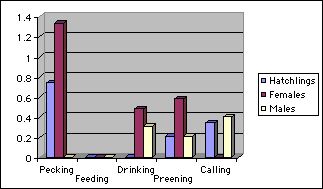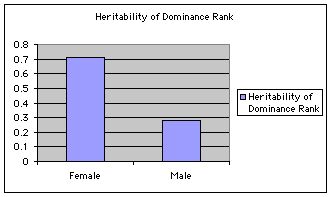
Dominance and Heritability in Japanese Quail
Both male and female Japanese quail, Coturnix japonica, start pecking other birds soon after hatching. In adults, males and females establish dominance hierarchies. Nol et al. (1996) determined heritability for a large number of behaivoral traits in Japanese quail (representative data are shown in Figure 1).


Figure 2. (drawn from data in Nol et al. 1996). Dominance rank has a higher heritability for males than for females in Japanese quail. Heritability may be maintained in females because the trait has no fitness consequences or because there are balancing factors.
Mating by males depends on their dominance; consequently a hypothesis that strong selection has reduced additive genetic variation for dominance in males is suppported.
Nol E., Cheng K., Nichols C. 1996. Heritability and phenotypic correlations of behaviour and dominance rank of Japanese quail. Animal Behaviour 52: 813-820
page 4-*
copyright ©2001 Michael D. Breed, all rights reserved